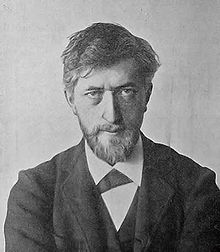
The Great Relief (Danish : Det Store Relief) is a sculpture by the Danish artist J.F. Willumsen completed in 1928. Consisting mainly of marble and gilt bronze, it was included in the 2006 Danish Culture Canon as a masterpiece of Danish culture.

The Great Relief (Danish : Det Store Relief) is a sculpture by the Danish artist J.F. Willumsen completed in 1928. Consisting mainly of marble and gilt bronze, it was included in the 2006 Danish Culture Canon as a masterpiece of Danish culture.
Willumsen first thought of creating the relief when he was at the Chicago World Fair in 1893, envisaging it as a decoration for a wall in one of the city's bars. He started working on it after returning to Paris the same year and continued its development over the next five or six years in Copenhagen. But it was only when he had received an official commission for the work in 1920 that he worked towards its completion, using a large plaster wall specially erected in his house in Stradagervej as a base. Willumsen supervised the selection and cutting of the variously coloured pieces of Carrara marble in Lazzarini's Italian workshop. [1]
In his earliest notes on the work, Willumsen explained he intended to illustrate various degrees of happiness by using different symbols. The lowest degree, which he labels tragicomical, is strong but short-lived without any lasting effects. He sees it as being symbolized by "grotesque musicians". At the middle level comes sensuality or parody, not as powerful as the first but nevertheless leaving its traces. His symbol here is a man and a woman called "the parody". The strange thing is that the woman is dressed in men's battle attire while the man is dressed in a woman's clothes. According to Willumsen, the reaction of the opposite sex is a "quivering sensation" leaving a greater impression than the strong burst of humour at the lowest level. The third and highest level for Willumsen is aesthetic joy. To achieve it, the individual needs to have a sense of beauty. [2]
When presenting his work in 1928, Willumsen described it as a "collocation of figures for Willumsen's view of existence and human life". The relief, he explained, centres on two "giants", dividing it into positive and negative parts. "One of the giants, the one on the left, is designed to represent cool 'reflection', or perhaps more accurately cool 'calculation'. Above his outstretched right arm, there are two large figures to the left, a man in women's clothing called 'Weakness', tyrannized by a woman, an armour-clad fury called 'War'. The other giant, the one on the right, who is holding's the first one's hand, has a soft expression, he should perhaps be called 'Unsophistication' or 'Instinct', his eyes are closed. On his outstretched left art there are two large figures, a man: 'the Worker', the symbol of will and deed, and 'a Woman' who admiringly and affectionately presses the Worker's had against her throbbing heart." Around the six large figures, there are many smaller figures. They are people 'who along the way go through different states of mind such as rest, fear and suffering, moving in an anticlockwise direction, starting with 'the Worker' and finishing at life's greatest state of happiness 'the golden couple'. [3]
The Great Relief can be seen in J.F. Willumsens Museum in Frederikssund, open Thursday to Sunday from 10 am to 5 pm. [3]

Albert Bertel Thorvaldsen was a Danish-Icelandic sculptor and medalist of international fame, who spent most of his life (1797–1838) in Italy. Thorvaldsen was born in Copenhagen into a working-class Danish/Icelandic family, and was accepted to the Royal Danish Academy of Art at the age of eleven. Working part-time with his father, who was a wood carver, Thorvaldsen won many honors and medals at the academy. He was awarded a stipend to travel to Rome and continue his education.

Sir William Hamo Thornycroft was an English sculptor, responsible for some of London's best-known statues, including the statue of Oliver Cromwell outside the Palace of Westminster. He was a keen student of classical sculpture and was one of the youngest artists to be elected to the Royal Academy, in 1882, the same year the bronze cast of Teucer was purchased for the British nation under the auspices of the Chantrey Bequest.

Lama, Lamma, or Lamassu is an Assyrian protective deity.

The Chigi Chapel or Chapel of the Madonna of Loreto is the second chapel on the left-hand side of the nave in the Basilica of Santa Maria del Popolo in Rome. It is the only religious building of Raphael which has been preserved in its near original form. The chapel is a treasure trove of Italian Renaissance and Baroque art and is ranked among the most important monuments in the basilica.

Johannes Wiedewelt, Danish neoclassical sculptor. He became a court sculptor, introducing neoclassical ideals to Denmark in the form of palace decorations, garden sculptures and artifacts and, especially, memorial monuments. He was undoubtedly the best known Danish sculptor before Bertel Thorvaldsen.
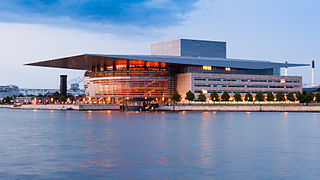
The Copenhagen Opera House is the national opera house of Denmark, and among the most modern opera houses in the world. It is also one of the most expensive opera houses ever built at a cost of 2.5 billion DKK. It is located on the island of Holmen in central Copenhagen.

Viggo Lauritz Bentheim Hørup was a Danish politician, journalist and agitator. He was the father of Ellen Hørup (1871-1953). He was one of the most influential politicians of the Danish non-Socialist left wing.

The Arca di San Domenico is a monument containing the remains of Saint Dominic. It is located in Dominic’s Chapel in the Basilica of San Domenico in Bologna, Italy.
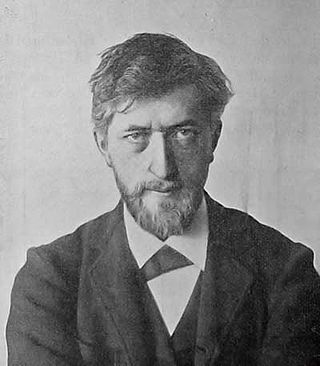
Jens Ferdinand Willumsen was a Danish painter, sculptor, graphic artist, architect and photographer. He became associated with the movements of Symbolism and Expressionism.

The "Song of the Bell" is a poem that the German poet Friedrich Schiller published in 1798. It is one of the most famous poems of German literature and with 430 lines one of Schiller's longest. In it, Schiller combines a knowledgeable technical description of a bellfounding with points of view and comments on human life, its possibilities and risks.

The Thorvaldsen Museum is a single-artist museum in Copenhagen, Denmark, dedicated to the art of Danish and Icelandic Neoclassical sculptor Bertel Thorvaldsen (1770–1844), who lived and worked in Rome for most of his life (1796–1838). The museum is located on the small island of Slotsholmen in central Copenhagen next to Christiansborg Palace. Designed by Michael Gottlieb Bindesbøll, the building was constructed from 1838 to 1848 following a public collection of funds in 1837.
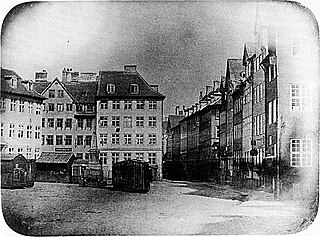
In Denmark, photography has developed from strong participation and interest in the very beginnings of the art in 1839 to the success of a considerable number of Danes in the world of photography today.

Carl Wilhelm Daniel Rohl-Smith was a Danish American sculptor who was active in Europe and the United States from 1870 to 1900. He sculpted a number of life-size and small bronzes based on Greco-Roman mythological themes in Europe as well as a wide number of bas-reliefs, busts, funerary monuments, and statues throughout Denmark, the German Confederation, and Italy. Emigrating to the United States in 1886, he once more produced a number of sculptures for private citizens. His most noted American works were a statue of a soldier for a Battle of the Alamo memorial in Texas, a statue of Benjamin Franklin for the World's Columbian Exposition in 1893, a statue group in Chicago commemorating the Fort Dearborn Massacre, and the General William Tecumseh Sherman Monument in Washington, D.C.
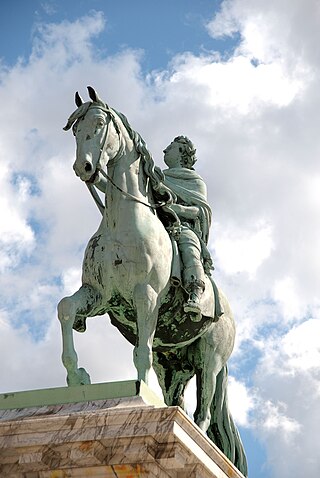
Danish sculpture as a nationally recognized art form can be traced back to 1752 when Jacques Saly was commissioned to execute a statue of King Frederick V of Denmark on horseback. While Bertel Thorvaldsen was undoubtedly the country's most prominent contributor, many other players have produced fine work, especially in the areas of Neoclassicism, Realism, and in Historicism, the latter resulting from growing consciousness of a national identity. More recently, Danish sculpture has been inspired by European trends, especially those from Paris, including Surrealism and Modernism.

Agnete and the Merman is a group of bronze sculptures in Copenhagen, Denmark, located underwater in the Slotsholm Canal next to the Højbro Bridge. It has been referred to as one of the least-known works of art in Copenhagen. The sculptures were made in 1992 by the Danish sculptor, photographer, and author, Suste Bonnen. They portray a merman and his seven sons with outstretched arms, begging Agnete to return home. Three other sculptures of merfolk are located in Copenhagen: the "Black Diamond Mermaid", a copy of Anne Marie Carl-Nielsen’s 1921 statue; a large (15-foot) granite mermaid located on the port-of-call cruise ship dock in Copenhagen; and the famous Little Mermaid statue, located on the water’s edge along Langelinie promenade.

Ingeborg Plockross Irminger (1872–1962) was a Danish artist who is remembered both for her sculptures and for the miniature porcelain statues of animals and human figures she designed while working for Bing & Grøndahl. A bronze cast of her 1903 bust of the writer Herman Bang was installed on Sankt Annæ Plads in Copenhagen in 2012.

The Tomb of Yu Hong (Chinese: 虞弘墓; pinyin: Yú Hóng Mù; Wade–Giles: Yü2-Hung2-Mu4) is the grave of Yu Hong and his wife, dating back to 592 AD (Sui dynasty). The tomb was discovered by some locals in 1999 in Wangguo village in Jinyuan district of the city of Taiyuan, it was subsequently excavated officially in July of the same year. This tomb is so far the only archaeological find in the Central Plains region that reflects Central Asian (Western Regions) culture.

Siegfried Wagner was a Danish sculptor.

Gerda Madvig was a Danish sculptress and painter.

The Statue of Asmus Jacob Carstens is a statue of German-Danish painter Asmus Jacob Carstens situated in the garden of the Ny Carlsberg Glyptotek, facing Niels Brocks Gade, in Copenhagen, Denmark. It was created by Theobald Stein in 1878–1879 and moved to its current location in 1894. It is complemented by a statue of Georg Zoëga facing Tietgensgade on the other side of the museum. The monument is flanked by two other bronze statues, Jules Dalou's Field Worker (1893) and Constantin Meunier's The Hammerman.